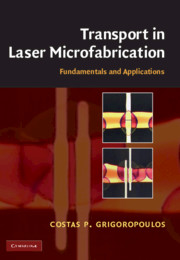Book contents
- Frontmatter
- Contents
- Preface
- 1 Fundamentals of laser energy absorption
- 2 Lasers and optics
- 3 Thermal processes in laser–materials interactions
- 4 Desorption at low laser energy densities
- 5 Dynamics of laser ablation
- 6 Ultrafast-laser interactions with materials
- 7 Laser processing of thin semiconductor films
- 8 Laser-induced surface modification
- 9 Laser processing of organic materials
- 10 Pulsed-laser interaction with liquids
- 11 Laser cleaning of particulate contaminants
- 12 Laser interactions with nanoparticles
- 13 Laser-assisted microprocessing
- 14 Nano-structuring using pulsed laser radiation
- Index
- References
6 - Ultrafast-laser interactions with materials
Published online by Cambridge University Press: 04 December 2009
- Frontmatter
- Contents
- Preface
- 1 Fundamentals of laser energy absorption
- 2 Lasers and optics
- 3 Thermal processes in laser–materials interactions
- 4 Desorption at low laser energy densities
- 5 Dynamics of laser ablation
- 6 Ultrafast-laser interactions with materials
- 7 Laser processing of thin semiconductor films
- 8 Laser-induced surface modification
- 9 Laser processing of organic materials
- 10 Pulsed-laser interaction with liquids
- 11 Laser cleaning of particulate contaminants
- 12 Laser interactions with nanoparticles
- 13 Laser-assisted microprocessing
- 14 Nano-structuring using pulsed laser radiation
- Index
- References
Summary
Introduction
Lasers that can produce coherent photon pulses with durations in the femtosecond regime have opened up new frontiers in materials research with extremely short temporal resolution and high photon intensity. The ultrafast nature of femtosecond lasers has been used to observe, in real time, phenomena including chemical reactions in gases (Zewail, 1994) and electron–lattice energy transfer in solids (Shah, 1996). On the other hand, ultra-short laser pulses impart extremely high intensities and provide precise laser-ablation thresholds at substantially reduced laser energy densities. The increasing availability of intense femtosecond lasers has sparked a growing interest in high-precision materials processing. In contrast to material modification using nanosecond or longer laser pulses, for which standard modes of thermal processes dominate, there is no heat exchange between the pulse and the material during femtosecond-laser–material interactions. As a consequence, femtosecond laser pulses can induce nonthermal structural changes driven directly by electronic excitation and associated nonlinear processes, before the material lattice has equilibrated with the excited carriers. This fast mode of material modification can result in vanishing thermal stress and minimal collateral damage for processing practically any solid-state material. Additionally, damage produced by femtosecond laser pulses is far more regular from shot to shot. These breakdown characteristics make femtosecond lasers ideal tools for precision material processing.
Thorough knowledge of the short-pulse-laser interaction with the target material is essential for controlling the resulting modification of the target's topography.
- Type
- Chapter
- Information
- Transport in Laser MicrofabricationFundamentals and Applications, pp. 146 - 201Publisher: Cambridge University PressPrint publication year: 2009

